 USA (1898): USS Illinois, Alabama, Wisconsin
USA (1898): USS Illinois, Alabama, WisconsinWW1 US Battleships:
USS Maine | USS Texas | Indiana class | USS Iowa | Kearsage class | Illinois class | Maine class | Virginia class | Connecticut class | Mississippi class | South Carolina class | Delaware class | Florida class | Arkansas class | New York class | Nevada class | Pennsylvania class | New Mexico class | Tennessee class | Colorado class | South Dakota class | Lexington classThe Illinois class were three pre-dreadnought battleships built in 1896-1901, missing the Spanish-American war, and now seen by historians as transitional ships incorporating many advances over preceding designs, like modern gun turrets, new rapid-firing secondary guns, while retaining like fire-tube boilers and Harvey armour. Standard speed was 16 knots, but they far exceeded this on trials. Illinois served with the North Atlantic and European Squadron, Wisconsin was flagship of the Pacific Fleet/Asiatic Fleet. Illinois and Alabama took part in the Great White Fleet cruise of December 1907. They were modernized in 1909 and remained with the Atlantic Fleet, but by 1912, they had been reduced to reserve, and training ships in World War I, until decommissioned by 1920. Illinois became the floating arsenal Prairie State, still around in 1941, only sold in 1956. Alabama ended as target ship in September 1921, proving Mitchell’s theories about air attacks.
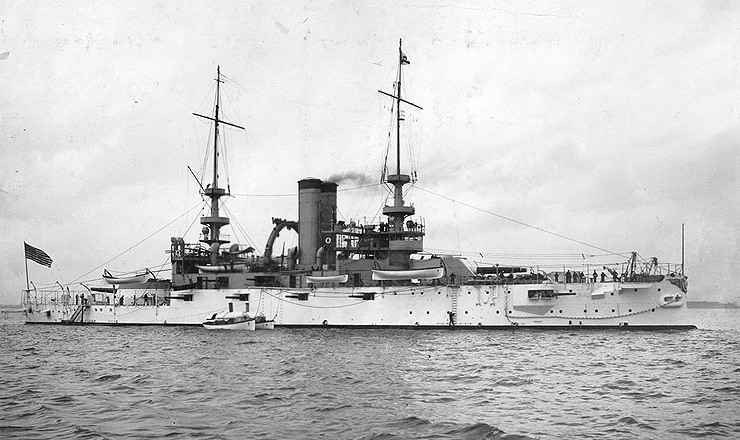
Development
Design work on the Illinois class started on 25 March 1896 under Rear Admiral J. G. Walker. He presided a board to consider future battleship designs, looking at what was done in Europe at the time. It was quickly agreed that the low-freeboard Indiana were good enough for coastal defence, but not for sea going operations, and thus a new type of high-freeboard battleship, like USS Iowa was more desirable than a low-freeboard Kearsarge class also under construction. Experience was still lacking for modern battleships and some still argued in favour of low-freeboard designs, partly reassuring the Congress as these ships were intended for coast defence. It was proposed to build another Iowa, while some wanted a brand-new design, innovating on many aspects. The Walker Board eventually decided against a new coastal battleship design to defend the US long coastlines, and that a new class need to have better seakeeping qualities than the Indiana or Kearsarge.
War games were also performed at the time at the academy. Their conclusion were transmitted to the board, helping them to specify a draft of 23 feet (7 m) to enter ports of the Mexico Gulf Coast, in shallow waters. This limitation dictated the new design and thus, displacement needed to be check in order to never achieve this figure, even fully loaded in battle order. This could be compensated with a larger beam, creating additional buoyancy, and the Iowa class design was taken as a comparative basis.
It was argued that the main armament needed to be reduced from 13-inch (330 mm) to 12 in (305 mm) guns, bu that concession was hard to come by. Thus, it was needed to design a brand new ship with some creative engineering solutions. The first was to eliminate the 8 in (203 mm) secondary guns of the Indiana class as unneccessary ad they if they were able to penetrate the thinner casemate armour on enemy battleships it lacked the high-explosive that can go through the armour and do real damage. The board instead decided to adopt the new 6 inches (152 mm) rapid-firing gun then in development, which would also simplify ammunition supply rather than a 3-caliber type.
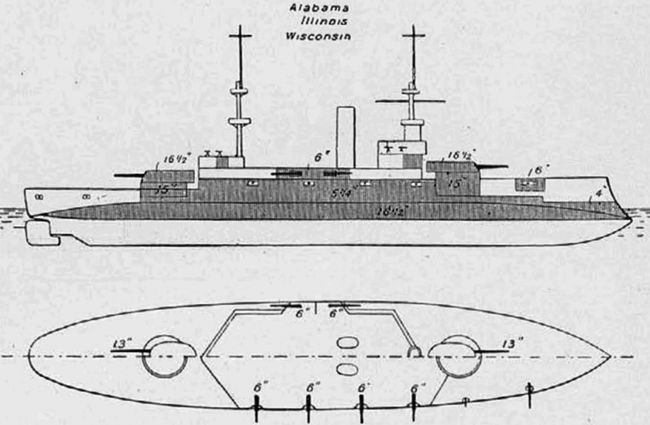
The board also worked on the armour layout, taking the Kearsarge design as a base as it was deemed “sufficient” with its Harvey scheme, and adopted without. Of course one glaringly mediocre “innovation”, its superposed turrets did not appear as such at the time, yet still, it was decided to mount most of the secondary guns on the battery amidships. The elimination of the tandem turret enabled to work on a more efficient protection for these, leading to a brand new, far more turret design than the “cheesebox” style. The new balanced turret looked at British battleships and would have face sloped armour. While it was balanced, it would not add extra listing when broadsided, eliminating one of the most grave issue with the previous Indiana’s.
In the end, the board concluded this ensemble of feature was highly desirable and the new design was submitted to the US Congress, which authorized three new battleships on 10 June 1896 based on it. The Bureau of Construction and Repair (BuC&R) then submitted requests for tenders to various shipbuilding companies, 12 days later. Contracts were awarded to Newport News Shipbuilding & Drydock Company (BB-7), William Cramp & Sons (BB-8) and Union Iron Works (BB-9) on 28 August, with the new ships voted after discussions “Illinois”, “Alabama”, and “Wisconsin”.
Design of the Illinois class
Hull & General Layout

The Illinois class battleships measured 368 feet (112 m) long at the waterline, 374 ft (114 m) overall, for a beam of 72 ft 3 in (22.02 m) and draft of 23 ft 6 in (7.16 m) as initially planned, albeit this was a bit more than the original limit of 23 feet. They displaced 11,565 long tons (11,751 t) as designed (later “standard”) but 12,250 long tons (12,450 t) when fully load.
The hull was relatively similar to USS Iowa, with a forecastle to see keeping but a lower aft deck to reduce weight. There was a pronounced ram, a bulwark on top of the stem, and a generally balanced over all design seen from above with symmetrical hull lines fore and aft and rounded poop. Unlike the Indiana and Iowa, for the first time they featured tandem funnels like contemporary British battleships, where the starboard and port series of boilers were each truncated into a single funnel, which were placed side by side. The bridge above the conning tower was relatively developed, with an enclosed, well furnished wooden-panelled bridge and an open bridge above. In addition, for spotting, they were fitted with heavy military masts, with cylindrical bases like the ones sported by French and British battleships at the time. However, they were replaced by cage masts in 1909.
The crew amounted to 40 officers and 496 enlisted men, but later in their career it went up to 690–713.
Armour

These ships still had Harvey armor, the last to rely on Harvey steel, duento the adption without change of the Kearsage’s scheme. The process was now obsolete (1894) and now bested by the Krupp armor.
Main armored belt: 16.5 in (419 mm) over magazines/machinery spaces
Tapered to 9.5 in (241 mm) on the lower edge, then 4 in (102 mm) to the bow.
Transverse bulkheads: 12 in (305 mm) connected to the central belt and main battery barbettes.
Armored deck: 2.75 in (70 mm) on flat, sloped to the sides at 3 in (76 mm) forward, 5 in (127 mm) aft.
Conning tower: 10-in sides, 2 in (51 mm) roof.
Main turrets: 14-inch (356 mm) faces, 3 in (76 mm) roofs
Main barbettes: 15 in (381 mm) down to 10 in (254 mm) below deck. Armor that was thick protected the
Secondary battery: 6 in (152 mm) backed by coal bunkers on her lower portion.
Anti-splinter bulkheads: 1.5 in (38 mm) between each secondary guns.
Powerplant
The Illinois class battleships had two shaft triple-expansion steam engines, rated for 10,000 indicated horsepower (7,500 kW), fed by eight coal-fired fire-tube boilers trunked into a pair of funnels. This arrangement of fire-tube boilers was judged not efficient and replaced by lighter water-tube boilers on the next ships. Top speed was 16 knots (30 km/h; 18 mph) as contracted. On trials, the yards received bonuses as Illinois reached 17.45 knots (32.32 km/h; 20.08 mph) based on 12,757 ihp (9,513 kW). In all, they could carry up to 1,270 long tons (1,290 t) of coal, enough to steam for 4,190 nautical miles (7,760 km; 4,820 mi) at 10 knots (19 km/h; 12 mph).
Steering used a single, large rectangular rudder, which was efficient, giving them a turning radius of 362 yards (331 m) at 12 knots (22 km/h; 14 mph). The Illinois’s transverse metacentric height was 2.7 feet (0.82 m) which was deemed sufficient and made them better gunnery platforms as both the Kearsage and Indianas. Coal storage varied between ship, BB7 carried 1400t, BB8 1,355t and BB9 1,310t.
Armament
The miracle was to preserve 13-inches guns, placing them in better turrets, then completing this by a large battery of quick-firing secondary guns, seemingly engaged in close-quarters, targeting enemy ships’s superstructures, or dealing with torpedo boats. Dispensing of the cumbersome 8-inches guns of the Kearsage and Indianas seemed a good move. This was completed by a generous array of 6-pdr guns and torpedo tubes, making for a well-rounded armament. BB8 differed from the others by having four instead of six 37mm/40 (1-pdr) Hotchkiss/Driggs-Schroeder Mk I guns. All had in complement four 7.6mm (0.3 inches)/90 “potato-masher” machine guns that could be placed on a pintle on deck and carried on shore for a landing party. There was enough weaponry on board to field a 200-men strong landing party.
2×2 13-in/35 Mark I
The 13-inch guns were 35 caliber long, using black powder, for a range of about 12,000 yards (11,000 m) at 15 degrees elevation.
It was tested on armour-plated, and was capable from 6,000 yards (5,500 m) to penetrate 10–12 inches (250–300 mm) of belt armour.
These four guns were in two centerline turrets like all pre-dreadnoughts fore and aft of the main structure.
The turrets were originally featuring sloping armor, but space requirements imposed larger rings, which were forbidden due to tonnage limits. So they ended with less effective flat sides. Fortunately, this was done for the next Illinois-class battleships. They also lacked a central spine and were simply put to rest by gravity on a ring, with rollers, manually traverse.
Worst still, there was counterweight to offset the weight of the gun barrels, and they followed the moves of the ships.
Low freeboard in rough weather conditions, saw deck awash and sea spray just blinded these guns.
Maximum elevation was just 5 degrees due to the mount’s limitations. It was considered in 1901 to replace these by new balanced turrets but rejected as too costly when the ships were considered obsolescent. Counterweights were added, though. The turrets were also now powered by electric motors with new sights and hoists on USS Indiana and Massachusetts, increasing their reloading speed. See also: on navweaps.com 13-in/35 mk1
14x 6-in/40 Mark 4
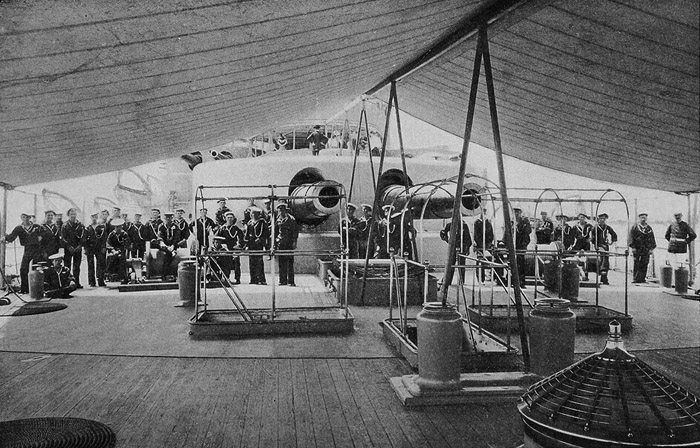
The smaller, but very recent (1896) 6-inch guns were mounted in the casemate battery amidship, with eight guns placed in the fore and aft faces, pointing forward, and four in the hull, broadsiding. They were all mounted on central-pivot with a mask. Production of the Mark 4 also went on to equip the Illinois class and Cincinnati class cruisers.
Specs:
Mass: 13,370 lb (6,060 kg) (without breech)
Length Mod 0: 256.1 in (6,500 mm), Barrel 240 in (6,100 mm) bore (40 calibers)
Shell: 105 lb (48 kg) naval AP, 6 in (152 mm)
Traverse: −150° to +150°
Rate of fire: 1.5 rounds per minute
Muzzle velocity: 2,150 ft/s (660 m/s)
Effective range: 9,000 yd (8,200 m) at 15.3° elevation
16x 6-pdr guns, 6x 1-pdr
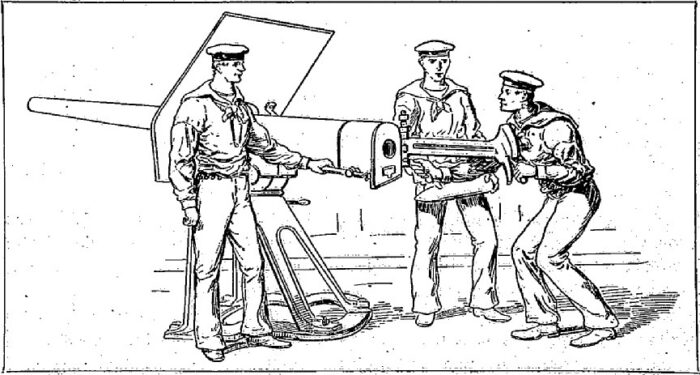
The sixteen Hotchkiss 6-pounders lined the superstructure and bridge decks. These classic Hotchkiss guns, exported all over the world, dated back from a 1885 design and were shoulder operated by a single man with assistant loaders. They had light flat shields as well.
Specs
Length: 8.1 ft (2.5 m), barrel 7.4 ft (2.3 m) 40 calibre
Shell: 57x307R or 57-millimetre (2.244 in)
Breech: Vertical sliding-block, Hydro-spring recoil.
Elevation, mount dependent, c20°.
Rate of fire: 25/minute
Muzzle velocity: 1,818 fps (554 m/s), effective range: 4,000 yards (3,700 m)
This was complemented by six 1-pounders (37 mm or 1.5 inches), four placed in hull casemates at the bow and stern, two more in the masts fighting tops.
Four Torpedo Tubes
Sources conflicts on torpedo tubes originally included in the design, they were located on the berth deck, in above-water ports forward and aft, then midship in a lozenge pattern. They were located too close to the waterline and vulnerable to gunfire when opened. Later they were considered useless reduced, then removed before 1908. Probably fired the first model of Bliss-Leavitt models derived from the Whitehead Mark 1.
⚙ specifications |
|
| Displacement | 11,565 long tons standard, 12,250 long tons FL |
| Dimensions | 375 ft 4 in x 72 ft 3 in x 23 ft 6 in (114.4 c 22.02 x 7.16 m) |
| Propulsion | 2× shafts TE steam engines, 8 × FT boilers: 10,000 ihp (7,500 kW) |
| Speed | 16 knots (30 km/h; 18 mph) |
| Range | |
| Armament | 4× 13 in/35, 14× 6 in/40, 16× 6-pdr, 6× 1-pdr, 4× 18 in TTs |
| Protection | Belt 4-16.5 in, Turrets 14 in, Barbettes 15 in, Casemates 6 in, CT 10 in |
| Crew | 536, see notes |
Modifications
In 1909-1912 all saw the removal of their 6-pdr (57mm/40) and all their torpedo tubes, for the installation of four 3-in(76mm)/50 Mk. III/V/VI AA guns and cage masts were installed in place of the military masts. In 1909-1912, Illinois alone was drydocked, and her old cylindrical boilers were replaced by 8 modern Mosher type models.
In 1919 after a career as training ships, the saw the removal of six secondary 6-in guns, and installation of two more 3-in(76mm)/52 Mk X AA guns.
The Illinois class in action
 USS Illinois (BB-7)
USS Illinois (BB-7)
USS Illinois was laid down at Newport News Shipbuilding & Drydock Company on 10 February 1897. She was launched on 4 October 1898 and commissioned on 16 September 1901 with Captain George A. Converse in command. First authorized, she was still the last to enter service. After her shakedown cruise in the Chesapeake Bay, and initial training, she departed on 20 November to test a brand-new floating dry dock in Algiers in Louisiana and bach at Newport News in January 1902 for fixes. For the reception of Prince Henry of Prussia that she hosted, she became flagship of Rear Admiral Robley D. Evans on 15-28 February. On 30 April, as flagship of Rear Admiral A.S. Crowninshield she departed for Europe, stopped in Naples on 18 May to take charge of the European Squadron. Apart training and ceremonial duties on 14 July, she ran aground outside Oslo, and was repaired in Chatham, left on 1 September to the Mediterranean and South Atlantic.
On 10 January 1903 she was assigned to the North Atlantic Fleet for four years between peacetime training exercises, gunnery practice, and ceremonial activities. She collided on 30 March 1903 with Missouri and on 31 July 1906 with Alabama. She also became the first to win the Battenberg Cup.
She was selected for the Great White Fleet, preceded by a naval review for President Theodore Roosevelt, in Hampton Roads. Her cruise to demonstrate American military power was targeted specially for Japan, with tensions rising after the Russo-Japanese War and in reaction to Japanese immigration to the US. This cruise was a deterrence scheme, essentially.
On 17 December she left Hampton Roads for the Caribbean, South America (stops at Port of Spain, Rio de Janeiro, Punta Arenas, Valparaíso), arrived in Mexico in March 1908 for three weeks of gunnery practice and to the South American Pacific coast to San Francisco, Seattle, Australia via Hawaii, stopping at Melbourne, Sydney, and Auckland, then the Philippines (Manila) and ending at Yokohama for 3 weeks of exercises and back to Subic Bay in November, Singapore on 6 December, the Indian Ocean, Colombo, Suez Canal (Port Said) and giving assistance after the earthquake in Sicily. Illinois, Connecticut, Culgoa were part of the relief effort. After a stop at Gibraltar to meet an international fleet, the great white fleet crossed the Atlantic back to Hampton Roads on 22 February 1909, after 46,729 nautical miles (86,542 km) and a new naval review for the president.
On 4 August 1909, Illinois was decommissioned in Boston for a major modernization and three more years active, then decommissioned on 16 April to 2 November 1912 for major training with the Atlantic Fleet and then training cruises with midshipmen from the US Naval Academy in 1913 and 1914, and TS in WWI. In 1919, she was decommissioned at the Philadelphia Navy Yard and on 23 October 1921, loaned to the NY Naval Militia for training but the 1922 Washington Naval Treaty for ce her conversion as a floating armory at the New York Navy Yard in 1924, part of the Reserve until 8 January 1941, when reclassified to IX-15 “Prairie State” freeing her name for a new battleship, and during that second war, used by the U.S. Naval Reserve Midshipmen’s School, then barracks ship from 1946, Naval Reserve unit. On 31 December 1955 she was stricken, sent to Baltimore, sold for scrap on 18 May 1956.
 USS Alabama (BB-8)
USS Alabama (BB-8)
USS Alabama was laid down at William Cramp & Sons on 2 December 1896, launched on 18 May 1898 and commissioned on 16 October 1900. She was the first of her class to enter service under the command of Captain Willard H. Brownson. Assigned to the North Atlantic Squadron, Philadelphia until 13 December she visited New York until January 1901 and on the 27th departed for the Gulf of Mexico for the North Atlantic Squadron’s winter training exercises off Pensacola. By August 1901 she was in target practice off of Nantucket Island when the crew was stricken by an outbreak of pumps so she was placed in quarantine instead.
For six years, fleet training routinely involved Winter Gulf of Mexico-Caribbean exercises, repairs/maintenance, and operations off the east coast mid- and summer yearly. In 1904 with Kearsarge, Maine, and Iowa, Olympia, Baltimore, and Cleveland she visited southern Europe via Lisbon and Naples by mid-August and back home via the Azores to Newport on 29 August. She was drydocked in September-December and on 31 July 1906, had a collision with Illinois. Like her sister, she was sent to take part of the Great White Fleet around the world. When in San Francisco, Alabama was detached for repairs due to a cracked cylinder head at Mare Island while Maine also left the fleet due to inefficient boilers.
On 8 June, Alabama and Maine independently crossed the Pacific via Honolulu to Guam, and Manila, Singapore in August, Indian Ocean via Colombo, Aden, Suez, Naples, Gibraltar and back in early October via the Azores on 19 October, parted company as Alabama sailed to New York, placed in reserve status on 3 November until 17 August 1909, decommissioned for a major overhaul until 1912, and fully recommissioned on 17 April 1912, Atlantic Reserve Fleet under Charles F. Preston. She had a reduced crew boosted by naval militiamen and volunteers if there was an emergency and officers in rotating groups, so she remained in good condition. On 25 July, she was in full commission for the summer training exercises until 10 September. By mid-1913 she started to train naval militia units off the east coast and Bermuda. On 31 October she was laid up and spent tile inactive at Philadelphia until 22 January 1917.
From there, she became a receiving ship for naval recruits, transferred to the southern Chesapeake in March and after 6 April (war declared) she became flagship of the 1st Division, Atlantic Fleet, training sailors on the east coast with a cruise to the Gulf of Mexico in June-July 1918. On 11 November with the Armistice, she reduced her training rate taking part in fleet manoeuvres in February-March 1919 in the Caribbean, and back at Philadelphia for maintenance, then summer training cruise for midshipmen from May via Annapolis starting on 9 June and via the Panama Canal, then July and August manoeuvres and back to Annapolis, then Philadelphia.
Decommissioned on 7 May 1920, USS Alabama was transferred to the War Department to be used as a target ship on 15 September 1921, stricken and allocated to the US Army Air Service on 27 September for trials supervised by General Billy Mitchell. New Jersey and Virginia were also “spent” in these bombing tests, starting on 23 September with chemical bombs, tear gas and white phosphorus killing sheep on board, then 300 lb (136 kg) demolition bombs in illumination that night; then the 1st Provisional Air Brigade (eight Royal Aircraft Factory S.E.5s with 25 lb (11 kg) bombs) made a first pass, complete with strafing mannequins with machine gun fire, followed by four Martin NBS-1 bombers with 300 lb (136 kg) bombs dropped from 1500 ft (457 m), making two hit, but later 1100 lb (499 kg) armour-piercing bombs missed.
On 25 September she was bombed by seven NBS-1s, three carrying 1,100 lb (499 kg) bombs, four having a single 2,000 lb (910 kg) bomb each. One of the lateter was a near-miss, port side and still caused considerable damage: Alabama started listing to port. Two more near-misses with 2,000 lb (907 kg) bombs and a direct hit, two more near misses with 1,100 lb (499 kg) bombs, then a 2,000 lb (907 kg) hit the stern, broke her anchor chains so she started to drift toward San Marcos and Indiana, already sunk earlier that year. She remained afloat for two days and sank in shallow water on 27 September. Mitchell exemplified her as evidence of the bombers to secure an independent air force. Her wreck was sold for BU on 19 March 1924. Efforts to rise her started by May 1926. Raised on 10 September 1927 she was tugged to Baltimore with a crew to keep electric pumps running and later beach her to start scrapping.
 USS Wisconsin (BB-9)
USS Wisconsin (BB-9)
USS Wisconsin was laid down at Union Iron Works on 9 February 1897, launched on 26 November 1898 and completed on 4 February 1901. She left San Francisco on 12 March to training in Magdalena Bay, Mexico on 17 March-11 April and back for fixes from 15 April-28 May. She left for Port Orchard (Washington) on 1 June, staying nine days and back to San Francisco to join Oregon and Iowa, Philadelphia, and Farragut for a tour of the West Coast: Port Angeles (Washington) on 29 June, Port Whatcom on 2 July, and Independence Day celebrations then training exercises until mid-July. Furthermore, she had maintenance in the drydock at Puget Sound on 23 July to 14 October and proceeded to Honolulu, Hawaii on 23 October, then Samoa for gunnery training, then Tutuila on 5 November, and departed with the collier Abarenda and hospital ship Solace to Apia, German Samoa, then on 21 November sailed back to for Hawaii and from there Central America, Acapulco on 25 December, Callao in Peru and Valparaíso in Chile, Acapulco on 26 February 1902, training in Magdalena Bay and Pichilinque Bay 5-22 March and back to the west coast via Coronado, San Francisco, Port Angeles, Puget Sound on 4 June for maintenance until 11 August.
She had gunnery training off Tacoma, then Seattle and left on 12 September for Panama to protect American interests there as flagship, Pacific Squadron, Rear Admiral Silas Casey III. She sent a landing party to protect US citizens and interests in the Thousand Days’ War while representatives from both sides had negotiations aboard Wisconsin, ending the conflict. She left Panama on 22 November for San Francisco, then Puget Sound until 13 May 1903, assigned to the Asiatic Fleet, sailed to Honolulu and proceeded to Yokohama on 12 June. Rear Admiral Philip H. Cooper made her his flagship on 15 June. She spent three years in the Asiatic Fleet, with operations off north China and Japan (summer), Philippines (winter) and many visits in Asia notably Kobe, Yokohama, Nagasaki, Amoy, Shanghai, Yantai, Nanjing, Taku. In September 1906 she returned to Honolulu and then San Francisco on 18 October, then Puget Sound to be decommissioned on 16 November for an overhaul until late April 1908. Back to San Francisco on 6 May for a naval review, she received modifications to her fire control equipment until 22 June.
In San Francisco by early July she joined the Great White Fleet as it passed there from Hampton Roads, back to Hampton Roads on 22 February 1909 and a naval review for President Theodore Roosevelt. She sailed to Portsmouth on the 9th, entered the dry-dock for repairs and received a new gray paint scheme, then in June she joined the Atlantic Fleet, Hampton Roads, then Portland, Maine, for Independence Day celebrations on 4 July and left on 6 August for gunnery training off the Virginia Capes, maintenance at Hampton Roads and then to New York for the Hudson–Fulton Celebration. She left on 5 October for maintenance at Portsmouth 7 October-28 November, back to Hampton Roads, and back to training with the Atlantic Fleet until mid-December, and Xmas in New York. In January 1910 she had winter exercises in Cuban waters, Guantánamo Bay, visited Tompkinsville and New Orleans and was back in New York to unload ammunition and entered the Portsmouth Navy Yard, Atlantic Reserve Fleet, then Philadelphia reserved in April 1912 and the naval review off Yonkers. Placed in ordinary on 31 October 1913 she was partially recommissioned in 1915, sent to the US Naval Academy Practice Squadron with Missouri and Ohio, cruising to the Pacific via Panama (just completed) herself being the 3rd battleship even to transit the canal.
Her role as TS went on until 1917, transferred to Philadelphia Navy Yard on 6 April and later placed in full commission with a complement of Naval Militia from 23 April, assigned to the Coast Battleship Patrol Squadron with Missouri and Ohio under Captain David F. Sellers. On 6 May she was off the Virginia Capes, Yorktown, and from August, became a training ship for engine room personnel in the Chesapeake Bay, with squadron exercises on 13-19 August with Kearsarge, Alabama, Illinois, Kentucky, Ohio, Missouri, and Maine. She trained later off Port Jefferson, then western Chesapeake in October, drydocked at Philadelphia NyD until 18 December. The next year she was back at Annapolis but was detached to look for the previously spotted U-151 on 23 May. She arrived at the academy on 7 June, took 175 midshipmen the following day for a training cruise to the Chesapeake. On 29 August she landed them and went to Yorktown to train 217 men, and by 11 November, Armistice Day, she went on in her training until 20 December. In New York, she took part in a naval review for Secretary of the Navy Josephus Daniels and Assistant Secretary Franklin D. Roosevelt on 26 December. She was then used as transport to ferry American soldiers back from France but was criticized for her poor accommodations and instead was sent to Cuba for training until 1919, followed by a midshipmen cruise in mid-1919. On 15 May 1920 she was decommissioned, reclassified as BB-9 on 17 July (name struck) and sold for scrap on 26 January 1922.
Sources
Books
Albertson, Mark (2007). U.S.S. Connecticut: Constitution State Battleship. Mustang: Tate Publishing.
Campbell, N. J. M. (1979). “United States of America”. Conway’s All the World’s Fighting Ships 1860–1905. Conway Maritime Press.
Friedman, Norman (2011). Naval Weapons of World War One. Annapolis: Naval Institute Press (NIP).
Friedman, Norman (1985). U.S. Battleships: An Illustrated Design History. NIP
“Illinois”. Dictionary of American Naval Fighting Ships. Naval History & Heritage Command.
“Wisconsin”. Dictionary of American Naval Fighting Ships. Naval History & Heritage Command.
ones, Jerry W. (1998). U.S. Battleship Operations in World War I. NIP
Wildenberg, Thomas (2014). Billy Mitchell’s War with the Navy: The Army Air Corps and the Challenge to Seapower. NIP
Alden, John D. (1989). American Steel Navy: A Photographic History of the U.S. Navy from the Introduction of the Steel Hull in 1883 to the Cruise of the Great White Fleet. NIP
Reilly, John C.; Scheina, Robert L. (1980). American Battleships 1886–1923: Predreadnought Design and Construction. NIP
Links
on navypedia.org wisconsin
wikipedia.org Illinois-class_battleship
commons.wikimedia.org Illinois_class


 Latest Facebook Entry -
Latest Facebook Entry -  X(Tweeter) Naval Encyclopedia's deck archive
X(Tweeter) Naval Encyclopedia's deck archive Instagram (@navalencyc)
Instagram (@navalencyc)


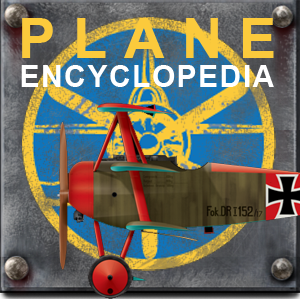
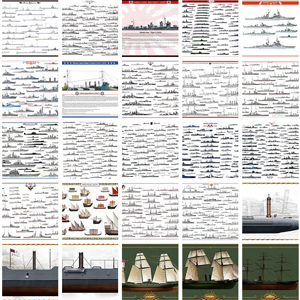

 French Navy
French Navy Royal Navy
Royal Navy Russian Navy
Russian Navy Armada Espanola
Armada Espanola Austrian Navy
Austrian Navy K.u.K. Kriegsmarine
K.u.K. Kriegsmarine Dansk Marine
Dansk Marine Nautiko Hellenon
Nautiko Hellenon Koninklije Marine 1870
Koninklije Marine 1870 Marinha do Brasil
Marinha do Brasil Osmanlı Donanması
Osmanlı Donanması Marina Do Peru
Marina Do Peru Marinha do Portugal
Marinha do Portugal Regia Marina 1870
Regia Marina 1870 Nihhon Kaigun 1870
Nihhon Kaigun 1870 Preußische Marine 1870
Preußische Marine 1870 Russkiy Flot 1870
Russkiy Flot 1870 Svenska marinen
Svenska marinen Søværnet
Søværnet Union Navy
Union Navy Confederate Navy
Confederate Navy Armada de Argentina
Armada de Argentina Imperial Chinese Navy
Imperial Chinese Navy Marinha do Portugal
Marinha do Portugal Mexico
Mexico Kaiserliche Marine
Kaiserliche Marine 1898 US Navy
1898 US Navy Sovietskiy Flot
Sovietskiy Flot Royal Canadian Navy
Royal Canadian Navy Royal Australian Navy
Royal Australian Navy RNZN Fleet
RNZN Fleet Chinese Navy 1937
Chinese Navy 1937 Kriegsmarine
Kriegsmarine Chilean Navy
Chilean Navy Danish Navy
Danish Navy Finnish Navy
Finnish Navy Hellenic Navy
Hellenic Navy Polish Navy
Polish Navy Romanian Navy
Romanian Navy Turkish Navy
Turkish Navy Royal Yugoslav Navy
Royal Yugoslav Navy Royal Thai Navy
Royal Thai Navy Minor Navies
Minor Navies Albania
Albania Austria
Austria Belgium
Belgium Columbia
Columbia Costa Rica
Costa Rica Cuba
Cuba Czechoslovakia
Czechoslovakia Dominican Republic
Dominican Republic Haiti
Haiti Hungary
Hungary Honduras
Honduras Estonia
Estonia Iceland
Iceland Eire
Eire Equador
Equador Iran
Iran Iraq
Iraq Latvia
Latvia Liberia
Liberia Lithuania
Lithuania Mandchukuo
Mandchukuo Morocco
Morocco Nicaragua
Nicaragua Persia
Persia San Salvador
San Salvador Sarawak
Sarawak Uruguay
Uruguay Venezuela
Venezuela Zanzibar
Zanzibar Warsaw Pact Navies
Warsaw Pact Navies Bulgaria
Bulgaria Hungary
Hungary

 Bundesmarine
Bundesmarine Dutch Navy
Dutch Navy Hellenic Navy
Hellenic Navy Marina Militare
Marina Militare Yugoslav Navy
Yugoslav Navy Chinese Navy
Chinese Navy Indian Navy
Indian Navy Indonesian Navy
Indonesian Navy JMSDF
JMSDF North Korean Navy
North Korean Navy Pakistani Navy
Pakistani Navy Philippines Navy
Philippines Navy ROKN
ROKN Rep. of Singapore Navy
Rep. of Singapore Navy Taiwanese Navy
Taiwanese Navy IDF Navy
IDF Navy Saudi Navy
Saudi Navy Royal New Zealand Navy
Royal New Zealand Navy Egyptian Navy
Egyptian Navy South African Navy
South African Navy






























 Ukrainian Navy
Ukrainian Navy dbodesign
dbodesign